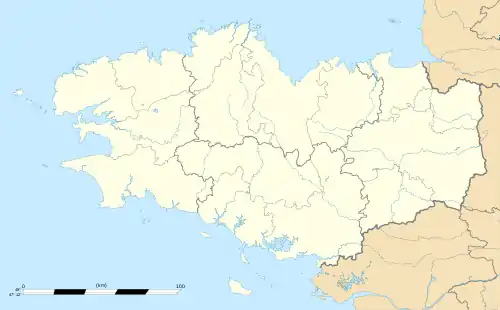Briec
Briec (formerly Briec-de-l'Odet), (Breton: Brieg) is a commune in the Finistère department in the region of Brittany in north-western France.
Briec
Brieg | |
|---|---|
 Town hall | |
.svg.png.webp) Coat of arms | |
Location of Briec 
| |
 Briec  Briec | |
| Coordinates: 48°06′10″N 3°59′50″W | |
| Country | France |
| Region | Brittany |
| Department | Finistère |
| Arrondissement | Quimper |
| Canton | Briec |
| Intercommunality | Pays Glazik |
| Government | |
| • Mayor (2014–2020) | Jean-Hubert Pétillon |
| Area 1 | 67.87 km2 (26.20 sq mi) |
| Population (2017-01-01)[1] | 5,630 |
| • Density | 83/km2 (210/sq mi) |
| Time zone | UTC+01:00 (CET) |
| • Summer (DST) | UTC+02:00 (CEST) |
| INSEE/Postal code | 29020 /29510 |
| Elevation | 44–225 m (144–738 ft) |
| Website | Official website |
| 1 French Land Register data, which excludes lakes, ponds, glaciers > 1 km2 (0.386 sq mi or 247 acres) and river estuaries. | |
Sights
- Saint-Pierre parish church, 15th century
- Chapelle de la Madeleine, 16th century
- Chapelle de Sainte-Cécile 16th century
- Chapelle Notre-Dame d'Illijour 19th century
- Chapelle Saint-Venec 16th century
- Chapelle Saint-Égarec 16th century
- Chapelle Saint-Sébastien 16th century
- Chapelle Saint-Corentin 16th century
List of mayors
- Jean-Hubert Pétillon 2014
- Jean-Paul Le Pann 2001/2014
- Joseph Bernard 1989/2001
- François Rolland 1981/1989
- Pierre Stephan 1959/1981
- Yves Le Page 1945/1959
- Jean Pennarun 1941/1945
- Hervé Merour 1929/1941
- Pierre Kerbourc'h 1925/1929
- Jean Pennarun 1919/1925
- Michel Croissant 1908/1919
- Jean Pennarun 1906/1908
- Michel Croissant 1904/1906
- Hervé Le Gac 1882/1904
- Pierre Dandurand 1878/1882
- Jean Bozec 1857/1878
- Jean Rolland 1855/1857
- Jean Kerbourch 1848/1855
- Hervé Le Berre 1827/1848
- François CreachcadicC 1806/1827
- Yves Le Gougay 1803/1806
- Jean Le Louet 1801/1803
- Le Hénaff 1796/1801
- Le Gougay 1794/1796
- François Ducap 1793/1794
- Yves Le Grand 01-1793/07-1793
- Henry Hémon 01-1792/01-1793
- Jean Pennanech 11-1791/12-1791
Population
Inhabitants of Briec are called in French Briecois.
| Year | Pop. | ±% |
|---|---|---|
| 1793 | 4,106 | — |
| 1800 | 4,521 | +10.1% |
| 1806 | 3,495 | −22.7% |
| 1821 | 4,191 | +19.9% |
| 1831 | 4,481 | +6.9% |
| 1836 | 4,592 | +2.5% |
| 1841 | 5,149 | +12.1% |
| 1846 | 5,310 | +3.1% |
| 1851 | 5,493 | +3.4% |
| 1856 | 5,437 | −1.0% |
| 1861 | 5,493 | +1.0% |
| 1866 | 5,726 | +4.2% |
| 1872 | 5,592 | −2.3% |
| 1876 | 5,906 | +5.6% |
| 1881 | 5,875 | −0.5% |
| 1886 | 6,175 | +5.1% |
| 1891 | 6,413 | +3.9% |
| 1896 | 4,765 | −25.7% |
| 1901 | 4,067 | −14.6% |
| 1906 | 4,403 | +8.3% |
| 1911 | 4,436 | +0.7% |
| 1921 | 4,367 | −1.6% |
| 1926 | 4,199 | −3.8% |
| 1931 | 3,935 | −6.3% |
| 1936 | 4,072 | +3.5% |
| 1946 | 3,848 | −5.5% |
| 1954 | 3,647 | −5.2% |
| 1962 | 3,425 | −6.1% |
| 1968 | 3,436 | +0.3% |
| 1975 | 3,744 | +9.0% |
| 1982 | 4,587 | +22.5% |
| 1990 | 4,546 | −0.9% |
| 1999 | 4,602 | +1.2% |
| 2008 | 5,244 | +14.0% |
Breton language
In 2008, 7.77% of primary-school children attended bilingual schools.[2]
See also
- Communes of the Finistère department
- The Briec monument aux morts has sculpture by Pierre Charles Lenoir
- Listing of the works of the Maître de Laz
References
- "Populations légales 2017". INSEE. Retrieved 6 January 2020.
- (in French) Ofis ar Brezhoneg: Enseignement bilingue
External links
| Wikimedia Commons has media related to Briec. |
- Base Mérimée: Search for heritage in the commune, Ministère français de la Culture. (in French)
- Mayors of Finistère Association (in French)
This article is issued from Wikipedia. The text is licensed under Creative Commons - Attribution - Sharealike. Additional terms may apply for the media files.